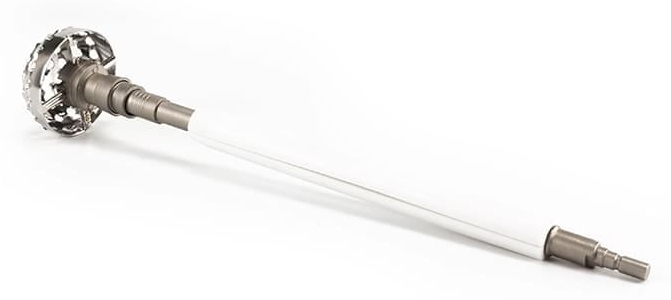As an orthopedic instrument, acetabular reamer shaft that connects reamers to power tools (electric/manual) for precise acetabular socket preparation during hip replacement surgery.
Main Appearance

Figure 1 Shaft for connecting the reamer

Figure 2 Shaft front end connection
Design & Materials
Acetabular reamer shaft is usually a slender rod-like structure with one end connected to the cutting head of the reamer drill and the other end connected to the drive unit, consisting of the following parts:
- Connecting End (Drive End)
- Shaft
- Drill Fixing End (Reamer Attachment End)
- Depth adjustment mechanism
When selecting materials for Acetabular reamer shafts, a combination of biocompatibility, strength and durability, corrosion resistance, machinability, economy and sterilisation properties need to be considered. There are generally the following material choices:
- Stainless steel: high strength, corrosion resistance and biocompatibility, a commonly used medical grade metal material.
- Titanium alloy: high strength, light weight and corrosion resistance and biocompatibility, lighter than stainless steel and equivalent performance, especially suitable for minimally invasive surgery.
- Cobalt chromium alloy: high strength, high hardness, wear-resistant, suitable for complex hip replacement surgery.
- Other materials: nickel-titanium alloy, titanium-molybdenum alloy, copper-nickel-titanium alloy, etc.
Functional Uses
- Power Transmission: Transmits power from the drive unit to the cutting head of the reaming drill, enabling it to rotate and perform reaming operations on the acetabulum.
- Stability and Control: Helps maintain the stability and precision of the reaming drill during the procedure.
- Information Display: The shaft displays the size of the reaming drill or other relevant information.
Clinical Applications
1. Total Hip Arthroplasty (THA)
- Acetabular Grinding: Connecting the reaming drill bit with the power tool, accurately grinding the acetabular socket to match the hemispherical structure of the artificial acetabular cup.
- Angle control: Adjust the abduction angle (40°~45°) and anterior inclination angle (15°~20°) to ensure the correct implantation of the prosthesis.
- Depth control: some shafts with scales or limiters to prevent bone loss due to overgrinding.
2. Hip revision
- Bone bed treatment: remove loose prosthesis and bone cement, trim irregular bone surface.
- Bone defect reconstruction: with large or eccentric reaming drills to accommodate bone defects (e.g. Paprosky fractional) and revision prostheses (reinforced cups/pads).
- Special design: Extended shaft for deep manipulation and enhanced grinding stability.
Consideration
- Cleaning and disinfection : Strict treatment before and after surgery to prevent infection
- Wear check : Regular check, replace immediately for serious wear
- Standard operation : Strictly follow the standard procedure to ensure safety and precision.
Regulatory Compliance
Acetabular reamer shafts are required to comply with ISO 13485 Quality Management System, ISO 14971 Risk Management, ISO 10993 Biocompatibility and ISO 5832 Material Standards, and to pass mechanical property tests and sterilisation validation.
Leading Manufacturers Bojin,Stryker, Zimmer Biomet, DePuy Synthes, and Medtronic are key producers of these specialized tools.
Noted: Different manufacturers provide different types of couplings.
